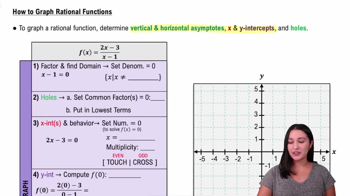Here are the essential concepts you must grasp in order to answer the question correctly.
Fractions and Decimals
Fractions represent a part of a whole and can be converted into decimals. The numerator indicates how many parts are taken, while the denominator shows the total number of equal parts. Understanding this relationship is crucial for converting fractions like 1/6 into their decimal equivalents.
Recommended video:
Radical Expressions with Fractions
Repeating Decimals
Repeating decimals occur when a decimal representation of a fraction has a digit or group of digits that repeat indefinitely. For example, 1/6 equals 0.1666..., where '6' repeats. Bar notation is used to denote this repetition, such as 0.1̅6̅, indicating that the '6' continues infinitely.
Recommended video:
How to Graph Rational Functions
Rounding Decimals
Rounding decimals involves adjusting the number to a specified place value, which simplifies the number while maintaining its approximate value. When rounding to the nearest thousandth, you look at the digit in the fourth decimal place to determine whether to round up or down, ensuring precision in numerical representation.
Recommended video:
 Verified step by step guidance
Verified step by step guidance Verified video answer for a similar problem:
Verified video answer for a similar problem:



 7:39m
7:39m